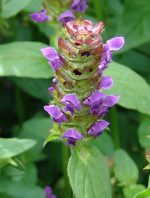 Also called carpenter’s weed and wild sage, heal-all is a herbaceous perennial and a member of the mint family, Lamiaceae, that also includes thyme, basil, and ajuga. It is native to North America and occurs throughout most of the US. Plants prefer moist soil in full sun and can be found in woodland edges, meadows, ditches, paths, roadsides, waste areas, gardens and lawns.
Also called carpenter’s weed and wild sage, heal-all is a herbaceous perennial and a member of the mint family, Lamiaceae, that also includes thyme, basil, and ajuga. It is native to North America and occurs throughout most of the US. Plants prefer moist soil in full sun and can be found in woodland edges, meadows, ditches, paths, roadsides, waste areas, gardens and lawns.
Description: Growing two to twenty four inches tall, heal-all has a a fibrous root system and square, tough reddish stems that branch at the leaf axis and root at the nodes. The stems are hairy when young but become smooth as they reach maturity. The ovoid leaves are opposite, reddish at the tip, and to one to four inches long. They have serrated margins and conspicuous leaf stems up to two inches long. From summer into fall the tubular flowers appear in spikes subtended by a pair of leaves and are two lipped, the top lip being purple and the bottom lip often white. Plants spread by seed and creeping stems that root at the nodes.
Control: Dig plants being careful to remove all stems so they will not root and produce new plants. Continue to dig plants every week or two until until no more plants appear. Alternatively, cover the area with a dense mulch such as newspaper or cardboard for a growing season. Mowing is not effective because plants can grow well under the mowing level. In severe cases herbicides can be applied. Effective post emergence herbicides are best applied during active growth and include 2,4-D, Cargentrazone, and Mesotrion.